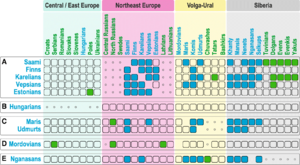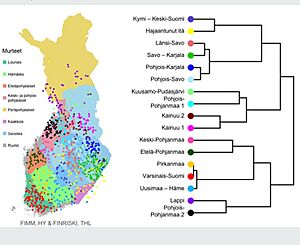Finns facts for kids
| Total population | |||||||||||||||||||||||||||||||||
|---|---|---|---|---|---|---|---|---|---|---|---|---|---|---|---|---|---|---|---|---|---|---|---|---|---|---|---|---|---|---|---|---|---|
| c. 6–7 million | |||||||||||||||||||||||||||||||||
| Regions with significant populations | |||||||||||||||||||||||||||||||||
| Finland c. 4.7–5.1 million
|
|||||||||||||||||||||||||||||||||
| United States | 653,222 | ||||||||||||||||||||||||||||||||
| Sweden | 156,045–712,000 (including Tornedalians) |
||||||||||||||||||||||||||||||||
| Canada | 143,645 | ||||||||||||||||||||||||||||||||
| Russia | 127,600 (with all Karelians) 34,300 (with Ingrian Finns) |
||||||||||||||||||||||||||||||||
| Australia | 7,939 | ||||||||||||||||||||||||||||||||
| Norway | 15,000–60,000 (including Forest Finns and Kvens) |
||||||||||||||||||||||||||||||||
| Germany | 33,000 (2022) | ||||||||||||||||||||||||||||||||
| United Kingdom | 15,000–30,000 | ||||||||||||||||||||||||||||||||
| Spain | 17,433 (in 2022) (up to 40,000 part-year residents) |
||||||||||||||||||||||||||||||||
| Estonia | 8,260 | ||||||||||||||||||||||||||||||||
| France | 7,000 | ||||||||||||||||||||||||||||||||
| Netherlands | 5,000 | ||||||||||||||||||||||||||||||||
| Italy | 4,000 | ||||||||||||||||||||||||||||||||
| Switzerland | 3,800 | ||||||||||||||||||||||||||||||||
| Brazil | 3,100 | ||||||||||||||||||||||||||||||||
| Denmark | 3,000 | ||||||||||||||||||||||||||||||||
| Belgium | 3,000 | ||||||||||||||||||||||||||||||||
|
|||||||||||||||||||||||||||||||||
| Languages | |||||||||||||||||||||||||||||||||
| Finnish and its dialects | |||||||||||||||||||||||||||||||||
| Religion | |||||||||||||||||||||||||||||||||
| Predominantly Lutheranism or irreligious, Eastern Orthodox minority | |||||||||||||||||||||||||||||||||
| Related ethnic groups | |||||||||||||||||||||||||||||||||
| Sámi, Balts, and other Baltic Finns Especially Karelians, Izhorians, Vepsians, Kvens, and Tornedalians |
|||||||||||||||||||||||||||||||||
|
The total figure is merely a sum of all the referenced populations listed. No official statistics are kept on ethnicity. However, statistics of the Finnish population according to first language and citizenship are documented and available. |
|||||||||||||||||||||||||||||||||
Finns or Finnish people (Finnish: suomalaiset) are a group of people who originally come from Finland. They are part of a larger group called Baltic Finns.
Finns are often divided into smaller groups based on where they live. These groups can be found in countries near Finland, like Norway, Sweden, and Russia. Some of these groups, like the Kvens and Forest Finns in Norway, or the Tornedalians in Sweden, are sometimes seen as separate ethnic groups.
The language Finns speak is Finnish. It is closely related to other languages like Estonian and Karelian. These languages belong to the Uralic language family, which is different from most other languages in Europe. Most European languages are part of the Indo-European family.
Today, about 6 to 7 million Finns and their descendants live around the world. Most of them live in Finland. Many also live in Sweden, Russia, and Norway. There are also many Finns who have moved to countries like America, Canada, Australia, New Zealand, and Brazil.
Contents
What "Finn" Means
The Finnish word for Finns is suomalaiset. If you're talking about one person, it's suomalainen.
Sometimes, people debate how to describe Finnish-speakers who live in Sweden. Many moved there after World War II. There are also Tornedalians, who have lived near the Swedish-Finnish border since the 1400s. The word "Finn" can also mean anyone who speaks Finnish or a similar language.
Where the Name "Finn" Comes From
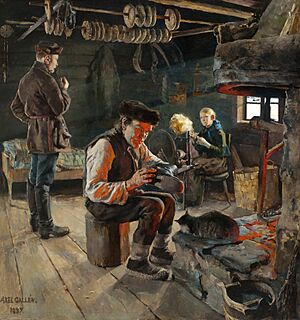
It's hard to know exactly where the name "Finn" comes from because old records about Northern Europe are rare. Names like Fenni and Finnum appeared in texts about 2,000 years ago. They were used for people in northern Europe. Some think the name comes from old Germanic words meaning "to find" or "wanderer." Others connect it to the word "fen" (a type of wet land).
The name Suomi, which is what Finns call their country, might have first been used for just the southwest part of Finland. Later, it became the name for the whole country and its language.
Some of the oldest mentions of Finns are in an old English poem from the 900s called Widsith. There are also two rune stones from the 1000s in Sweden that mention "Finlont" and "Finlandi."
History of the Finns
Early Origins

Like other groups speaking Uralic and Baltic Finnic languages, the ancestors of Finns likely came from an area in what is now Russia, between the Volga, Oka, and Kama rivers.
There were at least two big waves of people moving west. The first wave moved towards the Baltic Sea around 1250–1000 BC. The second main group arrived on Finland's southwest coast around 800 BC.
Over many generations, the Finnish language changed, but it kept its roots from the Finno-Ugric language family. Their culture also changed but kept its unique features, different from their neighbors. By the 6th and 7th centuries, the Finnish culture, especially how they used metal objects, became distinct. This time is also seen as the birth of the independent Finnish language.
Language Development
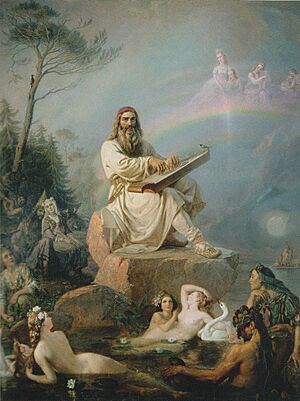
Experts believe that the Finnic languages and the Sami languages separated around 2000 BC. The very first Uralic languages might have started between 6000 and 8000 BC.
It's thought that the early form of Finnish (Proto-Finnic) was not spoken in modern Finland. Instead, it was spoken in what is now Estonia. This means Finnish was already a separate language when it arrived in Finland.
The Finnish language was only written down in the 1500s. Because of this, we don't have many old records about early Finnish life. For example, the exact origins of cultural things like the sauna and the kantele (a musical instrument) are still a bit of a mystery.
How Finns Lived
For a long time, Finns mainly made a living through farming, fishing, and hunting. In eastern Finland, people used "slash-and-burn" agriculture until the 1800s. This meant cutting down and burning forests to clear land for crops.
Farming helped set Finns apart from the Sámi people, who continued to hunt and gather for longer. The Sámi later moved to coastal fishing and reindeer herding. As Finland became more modern and industrialized, most Finns moved to cities and worked in factories or service jobs. Farming became a much smaller part of the economy.
Religious Beliefs
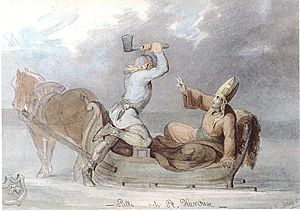
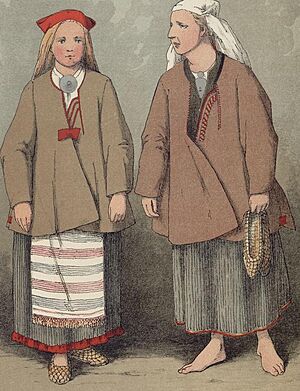
Christianity came to Finland during the Middle Ages. Before that, Finns had their own native traditions called Finnish paganism. This paganism mixed ideas from Finnic, Norse, Germanic, and Baltic beliefs.
- The Finnic people believed in a sky-god called Jumala.
- They also had a thunder-god, Ukko.
- Different parts of nature had their own protectors, like Ahti for water and Tapio for forests.
- People also honored local spirits called haltia and even practiced bear worship.
Christianity came from the east as Eastern Orthodoxy and from the west as Roman Catholicism. Swedish kings conquered western Finland in the late 1200s and brought Roman Catholicism.
Later, during the Reformation in Sweden, Bishop Mikael Agricola, a student of Martin Luther, created the first written Finnish language. This helped many people learn to read.
When Finland became independent, most people were Lutheran Protestant. A small number were Eastern Orthodox. Today, most Finns belong to the Evangelical Lutheran Church of Finland or have no religious affiliation. A smaller group belongs to the Finnish Orthodox Church.
Finnish Subgroups
Finns are traditionally thought to come from two different groups who spoke different early forms of Finnish: Western Finns and Eastern Finns. Within these, there are smaller groups, sometimes called heimo, based on their dialects and local culture.
- Western Finns
- People from Southwest Finland and Satakunta (called Finns proper)
- People from Tavastia (called Tavastians)
- People from Ostrobothnia (called Ostrobothnians)
- Southern, Central, and Northern Ostrobothnians
- People from Lapland (called Lapland Finns)
- Eastern Finns
- People from Karelia (called Finnish Karelians). Their Finnish dialects are different from the Karelian language spoken in Russia.
- People from Savonia (called Savonians)
- People from Kainuu (called Kainuu Finns)
- Finnish Minority Groups Outside Finland
- Tornedalians in Norrbotten, Sweden
- Forest Finns in Sweden and Norway
- Kvens in Finnmark, Norway
- Ingrian Finns in Ingria, Russia
- Finnish People Living Abroad
- Sweden Finns, who are Finns living in Sweden. About 450,000 people in Sweden are first or second-generation immigrants from Finland. Many moved there after World War II.
Today, the idea of heimo identity is strongest among Karelians, Savonians, and South Ostrobothnians.
Finnish Genetics
Scientists study DNA to learn about the history of human populations. They look at mitochondrial DNA (passed down from mothers) and Y-chromosomal DNA (passed down from fathers).
- The most common maternal DNA group among Finnish women is Haplogroup H.
- About one in four Finnish women have Haplogroup U5. This is thought to be a very old DNA group in Europe, found more often in Finns, Estonians, and the Sami people.
- For male DNA, the most common groups are N1c (about 58–60%) and I1a (about 26–28%). N1c is found mainly in Finland, Estonia, and parts of Russia, and it is thought to have come to Europe from Siberia.
Finns are genetically very close to Karelians and Vepsians, who are also Baltic Finnic groups. They also show some closeness to Northern Russians, who have some Finno-Ugric ancestors.
Finns often stand out genetically from their neighbors. Their genes show less variety and some differences in their mix of ancestries compared to most Europeans. While their genes are mostly European, they also have some East Eurasian ancestry (about 5-13%), likely from Siberia. This Siberian influence might have arrived in Northern Europe during the early Iron Age, possibly linked to the spread of Uralic languages.
Finns share more identical DNA segments with other Uralic-speaking groups, like Estonians, Sami, and even distant Komis and Nganasans, than with their Indo-European-speaking neighbors.
Even though Finnish genes are often described as similar, there are regional differences within Finland. Finns can be divided into Western and Eastern groups. The genetic difference between Western and Eastern Finns is quite large, sometimes even bigger than the difference between people from different European countries. This is because Eastern Finland was settled later by a smaller group of Finns, which led to unique genetic patterns. Eastern Finns also have more Siberian ancestry and a higher frequency of the N1c male DNA group.
Ideas About Where Finns Came From
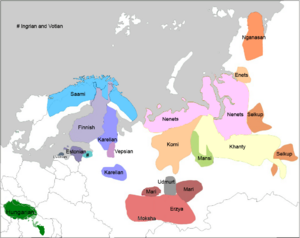
In the 1800s, a Finnish researcher named Matthias Castrén suggested that the original home of Finns was in west-central Siberia.
Until the 1970s, many language experts thought Finns arrived in Finland as late as the first century AD. However, archaeological findings now suggest that Finland has been lived in continuously since the end of the Ice age. This goes against the old idea that the area was empty for long periods. The hunter-gatherer Sámi people were gradually pushed into the northern regions.
A debated idea is the "refugia" theory, proposed by Kalevi Wiik in the 1990s. This theory suggests that Finno-Ugric speakers spread north after the Ice Age. They populated central and northern Europe. As farming spread across Europe, Indo-European languages also spread. According to Wiik, the ancestors of modern Finns kept their language because they lived in isolated areas. Many scholars have strongly disagreed with this theory.
Genetic studies have shown some support for the idea of "refugia" during the last Ice Age. However, this doesn't prove that these groups spoke Uralic or Finnic languages. Language and genetic changes can happen separately.
See also
 In Spanish: Pueblo finés para niños
In Spanish: Pueblo finés para niños
- Demographics of Finland
- Finnish language
- Finnish Americans
- Finnish Canadians
- Finnish Australians
- List of Finns




